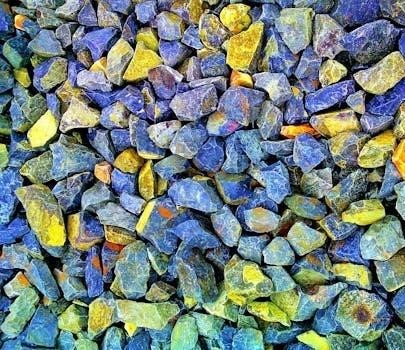Blue Willow china‚ a beloved collectible‚ features a distinctive blue design on white porcelain. This iconic pattern‚ with its roots in the 18th century‚ has captivated collectors for generations. Its intricate details and timeless charm make it a valuable find.
Brief history and origin of the Blue Willow pattern
The Blue Willow pattern‚ a classic example of chinoiserie‚ emerged in England during the late 18th century. It’s a transferware design‚ meaning the pattern is transferred from an engraved copper plate onto paper and then onto the ceramic. The design draws inspiration from Chinese motifs and became popular when English ceramic artists combined and adapted these into a distinctive style. While inspired by China‚ the pattern has no direct Chinese origin story‚ but rather it is a European interpretation of Chinese design elements. Its enduring appeal lies in its charming depiction of a romantic‚ albeit fabricated‚ Chinese legend. The pattern quickly spread‚ becoming a popular choice for tableware.

Identifying Key Elements of Blue Willow
The Blue Willow pattern is easily identified by its distinct elements such as a bridge‚ doves‚ a willow tree‚ a pagoda‚ and a fence‚ all rendered in blue on white.
The classic Willow pattern components⁚ bridge‚ doves‚ willow tree‚ pagoda‚ fence
The classic Blue Willow pattern is easily recognized by its consistent use of specific elements. These core components include a distinctive bridge‚ often arched and spanning a stream or river‚ and two doves‚ typically depicted in flight above the scene‚ symbolizing a romantic tale. A prominent willow tree‚ with its characteristic drooping branches‚ is another key feature‚ along with a traditional pagoda structure‚ adding to the Chinoiserie aesthetic. A fence‚ usually depicted in a geometric pattern‚ often encloses a part of the scene‚ providing a sense of depth and perspective. These elements collectively create the iconic and recognizable Blue Willow design‚ often replicated but never quite duplicated.
Variations in the Willow pattern and how to spot them
While the core elements of the Blue Willow pattern remain consistent‚ variations do exist and can be spotted by keen collectors. These variations may include differences in the number of fronds on the willow tree‚ with some versions having three sets and others four. The border designs can also vary‚ with some pieces having simple patterns and others more elaborate decorative elements. Subtle differences in the depiction of the bridge‚ pagoda‚ or doves can also indicate variations. Paying close attention to these details‚ including the inner and outer decorative borders‚ helps identify different iterations of the Blue Willow design. Some patterns mix in variations‚ confusing collectors‚ so close inspection is key.

Dating Blue Willow Pieces
Dating Blue Willow involves examining manufacturer marks‚ body type‚ and glaze characteristics. These elements provide clues to the age and origin of the piece‚ aiding collectors in identification.
Importance of manufacturer marks and their identification
Manufacturer marks are crucial for dating and authenticating Blue Willow pieces. These marks‚ often found on the base‚ can reveal the pottery that produced the item. However‚ it’s important to note that potters sometimes moved between factories‚ meaning an initial may identify the potter‚ but not necessarily the manufacturer. Researching these marks is vital; resources like Ruby Lane offer guides. Understanding these marks‚ including company symbols and date codes‚ can help distinguish between different eras and origins. This knowledge is key to determining the value and historical context of a piece‚ separating genuine pieces from reproductions.
Understanding body type and glaze characteristics for dating
Beyond manufacturer marks‚ the body type and glaze of Blue Willow pieces provide important clues for dating. Older pieces often have a heavier body and a unique glaze consistency‚ reflecting the manufacturing techniques of the period. The type of clay used and how it was fired can indicate the era and origin. Glaze variations‚ such as crazing or differences in color density‚ can also be significant. Examining these physical attributes‚ in combination with pattern details‚ helps determine the age and authenticity of Blue Willow. Knowledge of these factors separates older‚ more valuable pieces from modern reproductions.
Challenges in dating unmarked pieces
Dating unmarked Blue Willow pieces presents a significant challenge for collectors. The absence of manufacturer marks requires a deeper understanding of the pattern‚ body type‚ and glaze characteristics. While some pieces might be identifiable through specific design variations or telltale signs of production methods‚ many remain difficult to pinpoint. The body type‚ the glaze and the pattern itself can offer clues. Collectors rely on experience and detailed comparative analysis‚ often referencing known examples and historical production information. This process is crucial in separating older‚ more valuable pieces from later reproductions or unmarked copies‚ making dating a complex task.

Blue Willow Manufacturers
Several manufacturers have produced Blue Willow‚ including British companies like Spode‚ Churchill China‚ and Staffordshire. Chinese-made versions also exist‚ distinguishable by a “Made in China” marker‚ impacting their value.
Notable British manufacturers⁚ Spode‚ Churchill China‚ Staffordshire
British manufacturers hold a significant place in Blue Willow history‚ with Spode‚ Churchill China‚ and Staffordshire being among the most notable. Spode‚ known for its early production of the pattern‚ is highly sought after by collectors. Churchill China and Staffordshire also produced numerous pieces‚ contributing to the widespread popularity of Blue Willow. These British-made pieces are often considered antiques and are frequently identified through their distinct manufacturer’s marks. The quality and design details from these manufacturers often influence the value and desirability of the items‚ making their marks crucial for dating and authenticating pieces. Collectors often seek out pieces from these specific manufacturers due to their historical significance.
Chinese-made Blue Willow and its characteristics
While the Blue Willow pattern is often associated with British manufacturers‚ many pieces were also produced in China. Chinese-made Blue Willow can be identified by a “Made in China” marker‚ which distinguishes it from older British pieces. These items typically feature the classic Willow pattern‚ but may have slight variations in design or quality compared to their British counterparts. Chinese-made Blue Willow pieces are often more affordable and readily available‚ making them a good option for those starting a collection. Despite not being considered antique in most cases‚ they still contribute to the rich history and global reach of the Blue Willow pattern. The characteristics of the pattern can vary‚ so it is important to be able to compare pieces to identify origin and quality.

Value and Collectibility
Blue Willow’s value is influenced by factors like age‚ manufacturer‚ and condition. Rare examples and pieces from notable British makers are often highly sought after‚ making them valuable collectibles.
Factors influencing the value of Blue Willow pieces
Several factors determine the value of Blue Willow pieces‚ making some more desirable to collectors than others. The age of the piece is a significant factor; older pieces‚ especially those from the 18th and 19th centuries‚ typically command higher prices. The manufacturer also plays a crucial role‚ with pieces from renowned British makers like Spode‚ Churchill China‚ and Staffordshire often fetching premium prices. The condition of the item is also paramount‚ with pieces free from chips‚ cracks‚ or crazing being more valuable. The presence of maker’s marks can also greatly influence value‚ as these help in verifying authenticity and origin. Finally‚ the rarity of the pattern variations can increase desirability and value for collectors.
Identifying valuable and rare examples
Identifying valuable and rare Blue Willow examples requires a keen eye and knowledge of the pattern’s history. Look for pieces with unique variations in the classic design‚ such as differences in the number of fronds on the willow tree or unusual border patterns. Items with complete and well-preserved maker’s marks are highly sought after‚ as these help trace the piece’s origin and age. Pieces made by renowned manufacturers like Spode are generally more valuable. Also‚ consider the shape and size of the piece; unusual forms or larger platters might be more rare. Finally‚ pieces with historical significance or limited production runs are often considered highly valuable and rare.
Practical Tips for Collectors
Collectors should utilize online resources and guides to identify patterns and marks. Examine design elements‚ shapes‚ and maker’s marks carefully. Distinguish genuine pieces from fakes by comparing details.
Using online resources and guides for identification
Online resources and guides are invaluable tools for Blue Willow collectors. These platforms often provide access to extensive databases of manufacturer marks‚ pattern variations‚ and historical information. Utilizing search engines like Google Lens can help match patterns and identify potential manufacturers. Online communities and forums dedicated to Blue Willow can offer insights from experienced collectors‚ aiding in identification and authentication. Many websites offer comprehensive guides that illustrate the different elements of the pattern and variations. These resources can also help in understanding the value of specific pieces‚ allowing collectors to make informed decisions. Remember to compare information from multiple sources to ensure accuracy‚ and always be critical of information found online. Such a careful approach is essential for collectors of all levels.
Examining design elements‚ shapes and marks
Careful examination of design elements‚ shapes‚ and marks is crucial for identifying and valuing Blue Willow pieces. Pay attention to the classic components like the bridge‚ doves‚ willow tree‚ and pagoda‚ noting any variations. Observe the number of fronds on the willow tree‚ as this detail can sometimes indicate differences. The shapes of the pieces‚ such as plates‚ bowls‚ and platters‚ can also provide clues about their origin and period. Always scrutinize the manufacturer’s marks‚ as these are often key to dating and authentication. Be aware that some pieces may be unmarked‚ adding to the challenge of identification. Examine the glaze and body type‚ as these can offer further insights. Remember to look at both the inner and outer decorative borders for any unique features.
Distinguishing between genuine pieces and fakes
Distinguishing genuine Blue Willow from fakes requires a keen eye and thorough knowledge of the pattern. Be cautious of pieces with poor-quality printing or inconsistent details. Authentic pieces often exhibit a clear‚ crisp transferware design‚ while fakes may have blurry or uneven lines. Pay close attention to the color of the blue; genuine pieces usually have a consistent hue. Examine the glaze for authenticity‚ looking for signs of wear consistent with age. Fakes might have a too-new appearance or an overly glossy finish. Compare the piece to known examples in reputable resources‚ focusing on the details of the design and maker’s marks. If the price seems too good to be true‚ it likely is.
